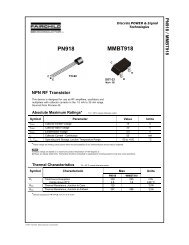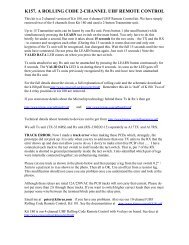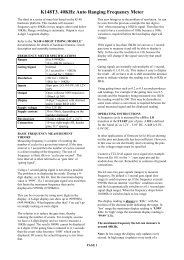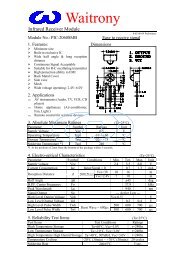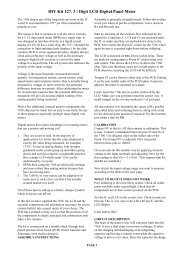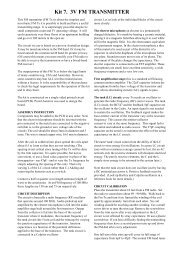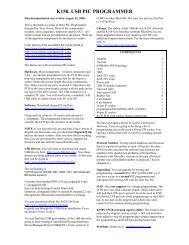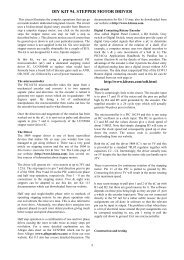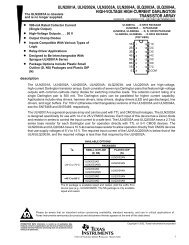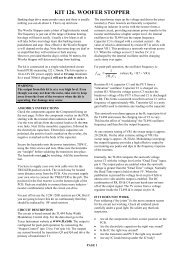K155. Stereo Tone Control Unit - Kitsrus
K155. Stereo Tone Control Unit - Kitsrus
K155. Stereo Tone Control Unit - Kitsrus
You also want an ePaper? Increase the reach of your titles
YUMPU automatically turns print PDFs into web optimized ePapers that Google loves.
<strong>K155.</strong> <strong>Stereo</strong> <strong>Tone</strong> <strong>Control</strong> <strong>Unit</strong><br />
his is a stereo tone control unit which will<br />
make a useful addition to many of our power<br />
amplifier kits. It provides +/-12 dB of bass and<br />
treble boost/cut, and channel balance control.<br />
Specification<br />
D.C. Input :<br />
Current Drain :<br />
Maximum output :<br />
Maximum input :<br />
Gain (loss) :<br />
Input Z :<br />
Frequency resp. :<br />
THD at 1kHz :<br />
S/N ratio :<br />
Bass boost/cut :<br />
Treble boost/cut :<br />
6V – 15V DC<br />
10 mA<br />
> 3 V RMS<br />
(12V DC supply)<br />
> 3 V RMS<br />
-2 dB.<br />
~50 k ohm<br />
< 20 Hz to > 50 kHz<br />
-3 dB<br />
< 0.1 % at 1V output<br />
> 85 dB re. 1V RMS<br />
~ 12 dB at 50 Hz<br />
~ 12 dB at 15 kHz<br />
How it works<br />
C1 couples the AC signal set by the volume and<br />
balance potentiometers to the base of Q1 via<br />
R2. Q1 acts as a class A, emitter follower,<br />
buffer stage. R1 and R3 set the DC voltage at<br />
base to allow maximum signal swing. R2<br />
determines the DC bias current and R4 provides<br />
the load impedance.<br />
The AC output is coupled by C2 to the input of<br />
IC1 via a variable filter network which is also<br />
part of the feedback loop. With the bass and<br />
treble pots at their centre position, the<br />
impedance of the feedback circuit is balanced<br />
and will give a fixed gain at all frequencies<br />
within the pass band When the pots are moved,<br />
the feedback ratio will increase or decrease at a<br />
frequency dependent rate governed by the<br />
capacitors C3 to C6 thereby providing the<br />
desired response curves.<br />
R8 and R9 provide a DC bias on the op-amp<br />
input to allow it to operate from a single DC<br />
supply. C7 prevents the AC signal from varying<br />
this DC voltage level. C8 and R10 couple the<br />
AC signal to the power amplifier whilst<br />
blocking the DC voltage present at the op-amp<br />
output. C9 and R11 provide power supply<br />
decoupling or filtering. If you are using a<br />
battery supply, you can replace R11 with a wire<br />
link to reduce battery consumption, although<br />
the difference is negligible.<br />
Construction<br />
NOTE:<br />
Some components are marked incorrectly on the<br />
PCB overlay:<br />
• Capacitor C11 (10u) is shown the wrong way<br />
around. The + lead should be to the left.<br />
• Resistors R1 and R13 are incorrectly labelled.<br />
They are 56K as per the schematic and parts<br />
list.<br />
• Resistors R3 and R15 are incorrectly labelled.<br />
They are 47K as per the schematic and parts<br />
list.<br />
Install the smaller components, starting with the<br />
resistors and the IC socket, with the notch as<br />
shown on the overlay. The IC will also have a<br />
notch or a dot at one end. Do not fit the IC until<br />
after you have soldered the socket into place<br />
though. Install the transistors, capacitors and<br />
PCB pins, leaving the pots until last. The<br />
volume pot is the log pot (A taper). Be careful<br />
when installing the transistors, they must go in<br />
the correct way as shown on the PCB overlay.<br />
The electrolytic capacitors are also polarised<br />
and the leads marked. The longer lead is<br />
positive, and should be inserted in the hole<br />
marked with the + sign.<br />
Use only shielded cable for the input and output<br />
connections, and make sure the power supply<br />
leads are as short as possible.<br />
Testing<br />
The power supply is critical to the noise<br />
performance of the pre-amp. A well regulated<br />
supply or plug pack should be used to reduce<br />
mains hum. However a regulator will not be<br />
necessary with a car or other battery supply.<br />
Make sure you test the voltage and polarity first<br />
in all cases before connecting to the board.<br />
Make sure the volume control is turned down,<br />
and that the other pots are centred. Then<br />
connect a music source and power amp, and<br />
increase the volume slowly. You should hear<br />
the music. Check the operation of the Bass,<br />
Treble and Balance controls, being careful not<br />
to use full boost at high volume.<br />
If there is no output, recheck all wiring, all<br />
Page 1 of 4
<strong>K155.</strong> <strong>Stereo</strong> <strong>Tone</strong> <strong>Control</strong> <strong>Unit</strong><br />
component positions and polarity of transistors,<br />
ecaps, and orientation of the IC. Check for bad<br />
solder joints, and solder bridges between tracks,<br />
especially the IC pins.<br />
The complete data sheet for the MC4558 IC<br />
can be obtained from our web site at :<br />
http://www.kitsrus.com<br />
PARTS LIST<br />
Resistors<br />
R1,R9,R13 .................56K (green,blue,orange)..... 3<br />
R2,R10,R14,R20 .......1K (brown,black,red) ......... 4<br />
R3,R8,R15 .................47K (yellow,violet,orange) . 3<br />
R4,R16.......................2K2 (red,red,red)............... 2<br />
R5,R6,R7,R17 ...........10K (brown,black,orange) .. 6<br />
R18,R19<br />
R11 ............................120R (brown,red,brown).... 1<br />
R12,R21.....................3K3 (orange,orange,red)..... 2<br />
Capacitors<br />
C1,C2,C8,C10 ...........10uF/25Vecap................. 6<br />
C11,C16<br />
C3,C4,C12,C13 .........33nF mono (333) ............ 4<br />
C5,C6,C14,C15..........3n3F mono (332) ............4<br />
C7 ..............................33uF/25V ecap................1<br />
C9 ..............................100uF/25V ecap..............1<br />
Misc<br />
IC1 .............................MC 4558.........................1<br />
Q1, Q2 .......................BC547.............................2<br />
VR1 100k dual gang log pot. (A) .......................1<br />
VR2 100k single gang linear pot. (B).................1<br />
VR3, VR4 50k dual gang linear pot. (B)............2<br />
Kit 155 Printed Circuit Board.............................1<br />
8 pin DIL IC socket ............................................1<br />
PCB pins.............................................................7<br />
Component Overlay<br />
NOTE:<br />
Some components are marked incorrectly on the PCB overlay:<br />
• Capacitor C11 (10u) is shown the wrong way around. The + lead should be to the left.<br />
• Resistors R1 and R13 are incorrectly labelled. They are 56K as per the schematic and parts list.<br />
• Resistors R3 and R15 are incorrectly labelled. They are 47K as per the schematic and parts list.<br />
Page 2 of 4
<strong>K155.</strong> <strong>Stereo</strong> <strong>Tone</strong> <strong>Control</strong> <strong>Unit</strong><br />
Circuit Diagram<br />
Left channel only (right channel components in brackets)<br />
Photo of completed circuit board.<br />
Page 3 of 4
THD at 1 kHz, 1V RMS output<br />
<strong>K155.</strong> <strong>Stereo</strong> <strong>Tone</strong> <strong>Control</strong> <strong>Unit</strong><br />
Effect of <strong>Tone</strong> <strong>Control</strong>s<br />
Maximum Boost / Cut<br />
Documentation Date: March 7, 2010<br />
Page 4 of 4



